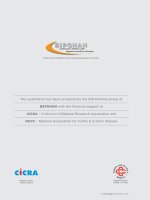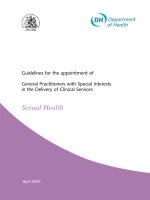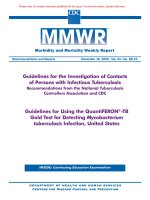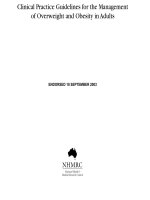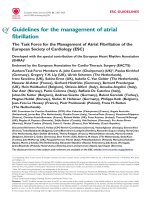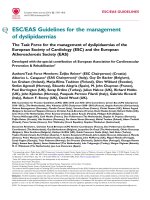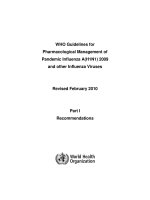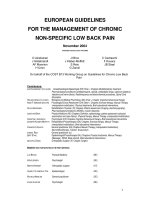EUROPEAN GUIDELINES FOR THE MANAGEMENT OF CHRONIC NON-SPECIFIC LOW BACK PAIN pot
Bạn đang xem bản rút gọn của tài liệu. Xem và tải ngay bản đầy đủ của tài liệu tại đây (937.7 KB, 207 trang )
1
EUROPEAN GUIDELINES
FOR THE MANAGEMENT OF CHRONIC
NON-SPECIFIC LOW BACK PAIN
November 2004
Amended version June 14th 2005
O Airaksinen JI Brox C Cedraschi
J Hildebrandt J Klaber-Moffett F Kovacs
AF Mannion S Reis JB Staal
H Ursin G Zanoli
On behalf of the COST B13 Working Group on Guidelines for Chronic Low Back
Pain
Contributors:
Pharmacological procedures (antidepressants, opioids, antiepileptic drugs, capsicum plasters),
Injections and nerve blocks, Radiofrequency and electrothermal procedures, Spinal Cord
Stimulation
Biological and Medical Psychology (NO) Chair + Chapter Cognitive behavioural therapy
A
NNE F. MANNION (EDITOR) Physiologist/Clinical Researcher (CH) Editor + Chapters Exercise therapy, Manual Therapy
(manipulation/mobilization), Physical treatments, Brief educational interventions,
O
LAVI AIRAKSINEN Rehabilitation Physician (FI) Chapters Patient assessment (imaging, electromyography),
Pharmacological procedures (NSAIDs, muscle relaxants)
J
ENS IVAR BROX Physical Medicine (NO) Chapters Definition, epidemiology, patient assessment (physical
examination and case history), Physical therapy, Manual Therapy (manipulation/mobilization)
C
HRISTINE CEDRASCHI Psychologist (CH) Chapters Cognitive behavioural therapy, Brief educational interventions
J
ENNIFER KLABER-MOFFETT Rehabilitation/Physiotherapist (UK) Chapters Exercise therapy, Manual Therapy
(manipulation/mobilization), Brief educational interventions
F
RANCISCO KOVACS General practitioner (ES) Chapters Manual Therapy (manipulation/mobilization),
Neuroreflexotherapy, Traction, Acupuncture
SHMUEL REIS General practitioner (IL)
B
ART STAAL Epidemiologist/Physiotherapist (NL) Chapters Physical treatments, Manual Therapy
(Massage), PENS, Back schools, Brief educational interventions
G
USTAVO ZANOLI Orthopaedic Surgeon (IT) Chapter Surgery
M
EMBERS WHO PARTICIPATED IN THE FIRST MEETINGS
L
UC BROOS Physical Medicine (BE)
I
RENE JENSEN Psychologist (SE)
M
ARTIN KRISMER Orthopaedic surgeon (AT)
C
HARLOTTE LEBOEUF-YDE Epidemiologist (DK)
W
ILHELM NIEBLING General practitioner (DE)
J
OHAN VLAEYEN Psychologist (BE)
HOLGER URSIN (CO-CHAIR)
J
AN HILDEBRANDT (CO-CHAIR) Anaesthesiologist/Algesiologist (DE) Chair + Chapters Multidisciplinary treatment,
2
A
DDITIONAL CONTRIBUTORS TO THE GUIDELINES DOCUMENT
S
TAFF AND STUDENTS OF University of Bergen, Norway Administrative and technical assistance.
DEPT. OF BIOL & MED PSYCH
AND HALOS/UNIFOB
D
AVID O’RIORDAN Schulthess Klinik, Zürich Assistance with summaries and quality rating of
exercise trials; assistance with literature management
E
MMA HARVEY University of Leeds Assistance cross-checking the SRs/RCTs on exercise
J
O JORDAN Chartered Soc Physio, UK Assistance with summaries and quality rating for
K
ATHERINE DEANE Uni Northumbria, UK additional exercise trials
3
Objectives
The primary objective of the European evidence-based guidelines is to provide a set
of recommendations that can support existing and future national and international
guidelines or future updates of existing back pain guidelines.
This particular guideline intends to foster a realistic approach to improving the
treatment of common (non-specific) chronic low back pain (CLBP) in Europe by:
1. Providing recommendations on strategies to manage chronic low back pain
and/or its consequences in the general population and in workers.
2. Ensuring an evidence-based approach through the use of systematic reviews and
existing evidence-based guidelines, supplemented (where necessary) by
individual scientific studies.
3. Providing recommendations that are generally acceptable to a wide range of
professions and agencies in all participating countries.
4. Enabling a multidisciplinary approach, stimulating collaboration between the
various players potentially involved in treatment, thus promoting consistency
across countries in Europe.
5. Identifying ineffective interventions to limit their use.
6. Highlighting areas where more research is needed.
Target population
The target population of this guideline on diagnosis and treatment of chronic non-
specific low back pain comprises individuals or groups that are going to develop new
guidelines (national or local) or update existing guidelines, and their professional
associations that will disseminate and implement these guidelines. Indirectly, these
guidelines also aim to inform the general public, people with low back pain, health
care providers, health promotion agencies, industry/employers, educationalists, and
policy makers in Europe.
When using this guideline as a basis, it is recommended that guideline
development and implementation groups should undertake certain actions and
procedures, not all of which could be accommodated under COST B13. These will
include: taking patients’ preferences into account; performing a pilot test among
target users; undertaking external review; providing tools for application; considering
organisational obstacles and cost implications; providing criteria for monitoring and
audit; providing recommendations for implementation strategies (van Tulder et al
2004). In addition, in the absence of a review date for this guideline, it will be
necessary to consider new scientific evidence as it becomes available.
The recommendations are based primarily on the available evidence for
the effectiveness and safety of each treatment. Availability of the treatments across
Europe will vary. Before introducing a recommended treatment into a setting where it
is not currently available, it would be wise to consider issues such as: the special
training needs for the treating clinician; effect size for the treatment, especially with
respect to disability (the main focus of treatments for CLBP); long-term
cost/effectiveness in comparison with currently available alternatives that use a
similar treatment concept.
Guidelines working group
The guideline group on chronic, non-specific low back pain was developed within the
framework of the COST ACTION B13 ‘Low back pain: guidelines for its
management’, issued by the European Commission, Research Directorate-General,
department of Policy, Co-ordination and Strategy. The guidelines Working Group
(WG) consisted of experts in the field of low back pain research. Members were
invited to participate, to represent a range of relevant professions. The core group
4
consisted of three women and eight men from various disciplines, representing 9
countries. None of the 11 members believed they had any conflict of interest.
The WG for the chronic back pain guidelines had its first meeting in May 2001 in
Amsterdam. At the second meeting in Hamburg, in November 2001, five sub-groups
were formed to deal with the different topics (patient assessment; medical treatment
and invasive interventions; exercise and physical treatment and manual therapy;
cognitive behavioural therapy and patient education; multidisciplinary interventions).
Overall seven meetings took place, before the outline draft of the guidelines was
prepared in July 2004, following which there was a final meeting to discuss and
refine this draft. Subsequent drafts were circulated among the members of the
working group for their comments and approval. All core group members contributed
to the interpretation of the evidence and group discussions. Anne Mannion played a
major role in editing (language and content) the whole document in the final stages.
The guidelines were reviewed by the members of the Management Committee of
COST B13, in Palma de Mallorca on 23
rd
October 2004. The full guidelines are
available at: www.backpaineurope.org
References
1. van Tulder MW, Tuut M, Pennick V, Bombardier C, Assendelft WJ (2004) Quality
of primary care guidelines for acute low back pain. Spine, 29(17): E357-62.
5
Summary of the concepts of diagnosis in chronic low back pain (CLBP)
• Patient assessment
Physical examination and case history:
The use of diagnostic triage, to exclude specific spinal pathology and nerve root
pain, and the assessment of prognostic factors (yellow flags) are recommended.
We cannot recommend spinal palpatory tests, soft tissue tests and segmental
range of motion or straight leg raising tests (Lasegue) in the diagnosis of non-
specific CLBP.
Imaging:
We do not recommend radiographic imaging (plain radiography, CT or MRI),
bone scanning, SPECT, discography or facet nerve blocks for the diagnosis of
non-specific CLBP unless a specific cause is strongly suspected.
MRI is the best imaging procedure for use in diagnosing patients with radicular
symptoms, or for those in whom discitis or neoplasm is suspected. Plain
radiography is recommended for the assessment of structural deformities.
Electromyography:
We cannot recommend electromyography for the diagnosis of non-specific
CLBP.
• Prognostic factors
We recommend the assessment of work related factors, psychosocial distress,
depressive mood, severity of pain and functional impact, prior episodes of LBP,
extreme symptom reporting and patient expectations in the assessment of
patients with non-specific CLBP.
Summary of the concepts of treatment of chronic low back pain (CLBP)
• Conservative treatments:
Cognitive behavioural therapy, supervised exercise therapy, brief educational
interventions, and multidisciplinary (bio-psycho-social) treatment can each be
recommended for non-specific CLBP. Back schools (for short-term
improvement), and short courses of manipulation/mobilisation can also be
considered. The use of physical therapies (heat/cold, traction, laser, ultrasound,
short wave, interferential, massage, corsets) cannot be recommended. We do
not recommend TENS.
• Pharmacological treatments: The short term use of NSAIDs and weak opioids
can be recommended for pain relief. Noradrenergic or noradrenergic-
serotoninergic antidepressants, muscle relaxants and capsicum plasters can be
considered for pain relief. We cannot recommend the use of Gabapentin.
• Invasive treatments:
Acupuncture, epidural corticosteroids, intra-articular (facet) steroid injections,
local facet nerve blocks, trigger point injections, botulinum toxin, radiofrequency
facet denervation, intradiscal radiofrequency lesioning, intradiscal electrothermal
therapy, radiofrequency lesioning of the dorsal root ganglion, and spinal cord
stimulation cannot be recommended for non-specific CLBP. Intradiscal injections
and prolotherapy are not recommended. Percutaneous electrical nerve
stimulation (PENS) and neuroreflexotherapy can be considered where available.
Surgery for non-specific CLBP cannot be recommended unless 2 years of all
other recommended conservative treatments — including multidisciplinary
approaches with combined programs of cognitive intervention and exercises —
have failed, or such combined programs are not available, and only then in
carefully selected patients with maximum 2-level degenerative disc disease.
6
Overarching comments
• In contrast to acute low back pain, only very few guidelines exist for the
management of CLBP.
• CLBP is not a clinical entity and diagnosis, but rather a symptom in patients with
very different stages of impairment, disability and chronicity. Therefore
assessment of prognostic factors before treatment is essential.
• Overall, there is limited positive evidence for numerous aspects of diagnostic
assessment and therapy in patients with non-specific CLBP.
• In cases of low impairment and disability, simple evidence-based therapies (i.e.
exercises, brief interventions, and medication) may be sufficient.
• No single intervention is likely to be effective in treating the overall problem of
CLBP of longer duration and more substantial disability, owing to its
multidimensional nature.
• For most therapeutic procedures, the effect sizes are rather modest.
• The most promising approaches seem to be cognitive-behavioural interventions
encouraging activity/exercise.
• It is important to get all the relevant players onside and to provide a consistent
approach.
Summary of recommendations for further research
In planning further research in the field of chronic non-specific low back pain, the
following issues/areas requiring particular attention should be considered.
Methodology
• Studies of treatment efficacy/effectiveness should be of high quality, i.e. where
possible, in the form of randomised controlled trials.
• Future studies should include cost-benefit and risk-benefit analyses.
General considerations
• Studies are needed to determine how and by whom interventions are best
delivered to specific target groups.
• More research is required to develop tools to improve the classification and
identification of specific clinical sub-groups of CLBP patients. Good quality RCTs
are then needed to determine the effectiveness of specific interventions aimed at
these specific risk/target groups.
• More research is required to develop relevant assessments of physical capacity
and functional performance in CLBP patients, in order to better understand the
relationship between self-rated disability, physical capacity and physical
impairment.
• For many of the conservative treatments, the optimal number of sessions is
unknown; this should be evaluated through cost-utility analyses.
Specific treatment modalities
Physical therapy
Further research is needed to evaluate specific components of treatments commonly
used by physical therapists, by comparing their individual and combined use. The
combination of certain passive physical treatments for symptomatic pain relief with
more “active” treatments aimed at reducing disability (e.g. massage, hot packs or
TENS together with exercise therapy) should be further investigated. The application
of cognitive behavioural principles to physiotherapy in general needs to be evaluated.
7
Exercise therapy
The effectiveness of specific types of exercise therapy needs to be further evaluated.
This includes the evaluation of spinal stabilisation exercises, McKenzie exercises,
and other popular exercise regimens that are often used but inadequately
researched. The optimal intensity, frequency and duration of exercise should be
further researched, as should the issue of individual versus group exercises. The
“active ingredient” of exercise programmes is largely unknown; this requires
considerably more research, in order to allow the development and promotion of a
wider variety of low cost, but effective exercise programmes. The application of
cognitive behavioural principles to the prescription of exercises needs to be further
evaluated.
Back schools, brief education The type of advice and information provided, the
method of delivery, and its relative effectiveness all need to be further evaluated, in
particular with regard to patient characteristics and baseline beliefs/behaviour. The
characteristics of patients who respond particularly well to minimal contact, brief
educational interventions should be further researched.
Cognitive-behavioural therapy
The relative value of different methods within cognitive-behavioural treatment needs
to be evaluated. The underlying mechanisms of action should also be examined, in
order to identify subgroups of patients who will benefit most from cognitive-
behavioural therapy and in whom components of pain persistence need addressing.
Promising predictors of outcome of behavioural treatment have been suggested and
need further assessment, such as treatment credibility, stages of change,
expectations regarding outcome, beliefs (coping resources, fear-avoidance) and
catastrophising.
The use of cognitive behavioural principles by professionals not trained in clinical
psychology should be investigated, to find out how the latter can best be educated to
provide an effective outcome.
Multidisciplinary therapy.
The optimal content of multidisciplinary treatment programmes requires further
research. More emphasis should be placed on identifying the right treatment for the
right patient, especially in relation to the extensiveness of the multidisciplinary
treatment administered. This should be accompanied by cost-benefit analyses.
Pharmacological approaches
Only very few data exist concerning the use of opioids (especially strong opioids) for
the treatment of chronic low back pain. Further RCTs are needed. No studies have
examined the effects of long term NSAIDs use in the treatment of chronic low back
pain; further studies, including evaluation of function, are urgently required. RCTs on
the effectiveness of paracetamol and metamicol (also, in comparison with NSAIDs)
are also encouraged. The role of muscle relaxants, especially in relation to longer-
term use, is unclear and requires further study.
Invasive treatments
Patient selection (in particular), procedures, practical techniques and choice of drug
all need further research. In particular, more high quality studies are required to
examine the effectiveness of acupuncture, nerve blocks, and radiofrequency and
electrothermal denervation procedures.
8
Surgery
Newly emerging surgical methods should be firstly examined within the confines of
high quality randomized controlled trials, in which “gold standard” evidence-based
conservative treatments serve as the control. Patients with failed back surgery
should be systematically analysed in order to identify possible erroneous surgical
indications and diagnostic procedures.
Methods not able to be recommended
It is possible that many of the treatments that ‘we cannot recommend’ in these
guidelines (owing to lack of/conflicting evidence of effectiveness) may indeed prove
to be effective, when investigated in high quality randomized controlled trials.
Many of these treatment methods are used widely; we therefore encourage the
execution of carefully designed studies to establish whether the further use of such
methods is justified.
Non-responders
The treatments recommended in these guidelines are by no means effective for all
patients with CLBP. Further research should be directed at characterising the sub-
population of CLBP patients that are not helped by any of the treatments considered
in these guidelines.
9
TABLE OF CONTENTS
Summary of evidence and recommendations
Chapter 1: Methods
Chapter 2: Low back pain definitions and epidemiology
Chapter 3: Patient assessment, and prognostic factors
A) Patient assessment
A1) Diagnostic triage
A2) Case history
A3) Physical examination: Lasegue test and spinal palpation and motion tests
A4) Imaging
A5) Electromyography
B) Prognostic factors
Chapter 4: Physical treatments
A) Interferential therapy
B) Laser therapy
C) Lumbar supports
D) Shortwave diathermy
E) Therapeutic ultrasound
F) Thermotherapy
G) Traction
H) Transcutaneous electrical nerve stimulation (TENS)
Chapter 5: Exercise therapy
Chapter 6: Manual therapy
A) Manipulation/mobilisation
B) Massage
Chapter 7: Back schools and brief educational interventions/advice to promote
self-care
A) Back schools
B) Brief educational interventions/advice to promote self-care
Chapter 8: Cognitive-behavioural therapy
Chapter 9: Multidisciplinary treatment
Chapter 10: Pharmacological procedures
A) Antidepressants
B) Muscle relaxants
C) NSAIDs
D) Opioids
E) Antiepileptic drugs (Gabapentin)
F) Capsicum pain-plasters
Chapter 11: Invasive procedures
A) Acupuncture
B) Injections and nerve blocks:
B1) Epidural corticosteroids and spinal nerve root blocks with steroids
B2) Facet block injections
B3) Intradiscal injections
B4) Intramuscular injections of botulinum toxin
B5) Sacroiliac joint injections
B6) Sclerosant injections (prolotherapy)
B7) Trigger point injections
C) Neuroreflexotherapy
D) Percutaneous electrical nerve stimulation (PENS)
E) Radiofrequency (RF) and electrothermal denervation procedures
E1) RF facet denervation
10
E2) IRFT and IDET
E3) RF lesioning of dorsal root ganglion
F) Spinal cord stimulation
G) Surgery
Appendix
Search strategies
11
Chronic LBP
Summary of evidence and recommendations
Chapter 2: Low back pain definitions and epidemiology
• The lifetime prevalence of low back pain is up to 84%.
• After an initial episode of LBP, 44-78% people suffer relapses of pain occur and
26-37%, relapses of work absence.
• There is little scientific evidence on the prevalence of chronic non-specific low
back pain: best estimates suggest that the prevalence is approximately 23%; 11-
12% population are disabled by low back pain.
• Specific causes of low back pain are uncommon (<15% all back pain).
Chapter 3: Patient assessment, and prognostic factors
C3 (A1-3) Patient assessment
Diagnostic triage, case history and physical examination
Summary of evidence
• Studies do not enable a valid evaluation of diagnostic accuracy of the straight
leg raising test (level B).
• No single test has a high sensitivity and specificity for radiculopathy, ankylosing
spondylitis or vertebral cancer (level B).
• There is conflicting evidence that spinal palpatory tests are reliable procedures
to diagnose back pain (level C)
• Pain provocation tests are the most reliable of the palpatory tests (level B)
• Soft tissue tests are unreliable (level A)
• Regional range of motion is more reliable than segmental range of motion (level
A)
• Intraexaminer reliability is better than interrater reliability for all palpatory tests
(level A)
• As palpatory diagnostic tests have not been established as reliable and valid, the
presence of the manipulable lesion remains hypothetical (B)
Recommendation
We recommend that diagnostic triage is carried out at the first assessment and at
reassessment in patients with chronic low back pain to exclude specific spinal
pathology and nerve root pain.
We recommend the assessment of prognostic factors (yellow flags) in patients with
chronic low back pain. The validity and relevance of these factors are discussed in
the section on prognostic factors.
We cannot recommend spinal palpatory and range of motion tests in the diagnosis of
chronic low back pain.
12
C3 (A4) Imaging
Summary of evidence
• There is moderate evidence that radiographic imaging is not recommended for
chronic non-specific low back patients (level B).
• There is moderate evidence that MRI is the best imaging procedure for use in
patients with radicular symptoms, or for those in whom discitis or neoplasm is
strongly suspected (level B).
• There is moderate evidence that facet joint injections, MRI and discography are
not reliable procedures for the diagnosis of facet joint pain and discogenic pain
(level B)
• SPECT and scintigraphy may be useful for diagnosing pseudoarthrosis after
surgery for spinal fusion, in suspected stress fractures in the evaluation of
malignancy, and in diagnosing symptomatic painful facet joints (level C).
Recommendation
We do not recommend radiographic imaging for chronic non-specific low back
patients.
We recommend MRI in patients with serious red flags and for evaluation of radicular
symptoms. Plain radiography is recommended for structural deformities.
We do not recommend MRI, CT, or facet blocks for the diagnosis of facet joint pain
or discography for discogenic pain.
C3 (A5) Electromyography (EMG)
Summary of evidence
• There is conflicting evidence that surface EMG is able to differentiate patients with
non-specific CLBP from controls and for monitoring rehabilitation programmes
(level C).
• There is limited evidence that fear-avoidance is associated with increased muscle
activity on lumbar flexion (level C).
• There is conflicting evidence for the usefulness of needle EMG in patients with
lumbar spinal stenosis and spinal radiculopathies (level C).
Recommendation
We cannot recommend the use of electromyography as a diagnostic procedure in
chronic non-specific low back pain.
C3 (B) Prognostic factors
Summary of evidence
• There is strong evidence that low work place support is a predictor of chronicity in
patients with acute back pain (level A).
• There is strong evidence that in the worker having difficulty returning to normal
occupational duties at 4-12 weeks the longer a worker is off work with LBP, the
13
lower the chances of ever returning to work; and that most clinical interventions
are quite ineffective at returning people to work once they have been off work for a
protracted period with LBP (level A).
• There is moderate evidence that psychosocial distress, depressive mood, severity
of pain and functional impact and extreme symptom report, patient expectations,
and prior episodes are predictors of chronicity (level B).
• There is moderate evidence that shorter job tenure, heavier occupations with no
modified duty, radicular findings, are predictors of chronicity (level B).
• There is moderate evidence that no specific physical examination tests are of
significant prognostic value in chronic non-specific LBP (level B)
Recommendation
We recommend that work related factors, psychosocial distress, patient
expectations, and extreme symptom reporting are assessed in patients with chronic
low back pain.
Chapter 4: Physical treatments
C4 (A) Interferential therapy
Summary of evidence
• There is no evidence for the effectiveness of interferential therapy compared with
sham/placebo treatments in the treatment of chronic low back pain (level D).
• There is limited evidence that interferential therapy and motorized lumbar traction
plus massage are equally effective in the treatment of chronic low back pain (level
C).
Recommendation
We cannot recommend interferential therapy as a treatment for chronic low back
pain.
C4 (B) Laser therapy
Summary of evidence
• There is conflicting evidence that laser therapy is effective for chronic low back
pain with regard to pain improvement (level C).
• There is limited evidence that there is no difference in effectiveness between laser
therapy, laser therapy and exercise and exercise (level C)
Recommendation
We cannot recommend laser therapy for the treatment of patients with chronic low
back pain.
14
C4 (C) Lumbar supports
Summary of evidence
• There is no evidence for the effectiveness of lumbar supports compared with
sham/placebo treatments in the treatment of chronic low back pain (level D).
• There is no evidence for the effectiveness of lumbar supports compared with other
treatments in the treatment of chronic low back pain (level D).
Recommendation
We cannot recommend the wearing of a lumbar support for the treatment of non-
specific chronic low back pain.
C4 (D) Shortwave diathermy
Summary of evidence
• There is no evidence for the effectiveness of shortwave diathermy compared with
sham/placebo treatments in the treatment of chronic low back pain (level D).
• There is no evidence for the effectiveness of shortwave diathermy compared with
other treatments in the treatment of chronic low back pain (level D).
Recommendation
We cannot recommend shortwave diathermy as a treatment for chronic low back
pain.
C4 (E) Therapeutic ultrasound
Summary of evidence
• There is limited evidence that therapeutic ultrasound is not effective in the
treatment of chronic low back pain (level C).
• There is no evidence for the effectiveness of therapeutic ultrasound compared
with other treatments in the treatment of chronic low back pain (level D).
Recommendation
We cannot recommend therapeutic ultrasound as a treatment for chronic low back
pain.
C4 (F) Thermotherapy
Summary of evidence
• There is no evidence for the effectiveness of thermotherapy compared with
sham/placebo treatments in the treatment of chronic low back pain (level D).
• There is no evidence for the effectiveness of thermotherapy compared with other
treatments in the treatment of chronic low back pain (level D).
Recommendation
We cannot recommend thermotherapy/heat as a treatment for chronic low back pain.
15
C4 (G) Traction
Summary of evidence
• There is limited evidence that lumbar traction is not more effective than sham
traction (level C).
•
There is no evidence for the effectiveness of lumbar traction compared with other
treatments in the treatment of chronic low back pain (level D).
Recommendation
We cannot recommend lumbar traction as a treatment for chronic low back pain.
C4 (H) Transcutaneous electrical nerve stimulation (TENS)
Summary of evidence
There is strong evidence that TENS is not more effective than placebo or sham
TENS in the treatment of chronic low back pain (level A).
There is moderate evidence that TENS is not more effective than vertebral axial
decompression, acupuncture, PENS, or electroacupuncture in the treatment of
chronic low back pain (level B).
Recommendation
We do not recommend TENS for the treatment of chronic low back pain.
Chapter 5: Exercise therapy
Summary of evidence
• There is moderate evidence that exercise therapy is more effective in the
reduction of pain and/or disability, at least in the short-term, than passive
treatments intended/considered to be control treatments by the authors of the
respective RCTs (level B).
• There is strong evidence that exercise therapy is more effective than “GP care” for
the reduction of pain and disability and return to work in at least the mid-term (3-6
months) (level A).
• There is strong evidence that exercise therapy alone is not more effective than
conventional physiotherapeutic methods in the treatment of chronic LBP (level A).
• There is conflicting evidence regarding the effectiveness of exercise as compared
with intensive multidisciplinary programmes (level C).
• There is strong evidence that strengthening/reconditioning exercises are no more
effective than other types of exercises in the treatment of chronic LBP (level A).
• There is limited evidence in each case that: there are no differences between
aerobic exercises, muscle reconditioning or physiotherapy exercises in relation to
pain or disability up to 12 months after treatment; there are no significant
differences between the effects on pain reduction of carrying out just 4 exercise
therapy sessions as opposed to 8 sessions; aerobic exercises are superior to
lumbar flexion exercises in terms of pain immediately after the programme; a
home exercise programme with individualised exercises is more effective than
one using general exercises; a combined exercise and motivational programme
shows a significantly larger decrease in pain and disability up to 12 months post-
treatment than does exercise alone (each, level C).
• There is conflicting evidence regarding the effectiveness of programmes involving
mainly trunk flexion exercises as compared with those involving mainly trunk
extension (level C).
16
• There is moderate evidence that individually supervised exercise therapy is not
more effective than supervised groups exercise (level B).
• There is strong evidence that the changes in pain and disability reported after
various types of exercise therapy are not directly related to changes in any aspect
of physical performance capacity (level A).
Recommendation
We recommend supervised exercise therapy as a first-line treatment in the
management of chronic low back pain.
We advocate the use of exercise programmes that do not require expensive training
machines. The use of a cognitive-behavioural approach, in which graded exercises
are performed, using exercise quotas, appears to be advisable. Group exercise
constitutes an attractive option for treating large numbers of patients at low cost. We
do not give recommendations on the specific type of exercise to be undertaken
(strengthening/ muscle conditioning, aerobic, McKenzie, flexion exercises, etc.). The
latter may be best determined by the exercise-preferences of both the patient and
therapist.
Chapter 6: Manual therapy
C6 (A) Manipulation/mobilisation
Summary of the evidence
• There is moderate evidence that manipulation is superior to sham manipulation for
improving short-term pain and function in CLBP (level B).
• There is strong evidence that manipulation and GP care/analgesics are similarly
effective in the treatment of CLBP (level A)
• There is moderate evidence that spinal manipulation in addition to GP care is
more effective than GP care alone in the treatment of CLBP (level B).
• There is moderate evidence that spinal manipulation is no less and no more
effective than physiotherapy/exercise therapy in the treatment of CLBP (level B).
•
There is moderate evidence that spinal manipulation is no less and no more
effective than back-schools in the treatment of CLBP (level B).
Recommendation
Consider a short course of spinal manipulation/mobilisation as a treatment option for
CLBP.
C6 (B) Massage
Summary of evidence
• There is limited evidence in each case that massage is more effective than: sham
procedures; remedial exercise and posture education; relaxation therapy (for pain
relief); acupuncture (long-term pain relief and function); self-care education (for
short-term pain relief and improvement of function); and general physical
therapies (for mid-term pain relief (each, level C)).
• There is limited evidence that massage and spinal manipulation are equally
effective for pain relief, but that massage results in less functional improvement
than spinal manipulation (each level C).
• There is limited evidence that there is no difference between massage and
transcutaneous muscle stimulation with regard to improvements in either pain or
17
function (level C). There is limited evidence that massage is less effective than
TENS in relieving pain (level C).
• There is limited evidence that there is no difference in the effectiveness of
massage and the wearing of a corset (level C).
• There is limited evidence that a combined treatment of massage with remedial
exercises and education is better than massage alone, remedial exercises alone
or sham laser therapy for short-term pain relief and improved function (level C).
• There is limited evidence that therapeutic acupuncture massage is more effective
than classical massage (level C).
Recommendation
We cannot recommend massage therapy as a treatment for chronic low back pain.
Chapter 7: Back schools and brief educational
interventions/advice to promote self-care
C7 (A) Back schools
Summary of evidence
• There is conflicting evidence for the effectiveness of back schools with regard to
pain, functional status and return to work, compared with waiting list controls or
‘placebo’ interventions (level C).
• There is moderate evidence that back school is more effective than other
treatments examined (simple advice, exercises only, manipulation) with regards to
pain and functional status in the short-term (level B). There is moderate evidence
for no difference between back schools and these other treatments with regard to
their long-term effects on pain and functional status (level B).
Recommendation
Consider back schools where information given is consistent with evidence-based
recommendations for short-term (<6 weeks) pain relief and improvements in
functional status. We do not recommend back schools as a treatment for chronic low
back pain when aiming at long-term effects (>12 months).
C7 (B) Minimal contact/brief educational interventions to promote
self-care
Summary of evidence
• There is moderate evidence that brief interventions addressing concerns and
encouraging a return to normal activities are better than usual care in increasing
return to work rates (level B).
• There is moderate evidence that brief interventions encouraging self-care are
more effective than usual care in reducing disability (up to 6 months) but not pain
(level B).
• There is limited evidence that Internet-based discussion groups/educational
interventions are more effective than no intervention in reducing disability (level
C).
• There is conflicting evidence that Internet-based discussion groups/educational
interventions are more effective than no intervention in reducing pain (level C).
• There is strong evidence that brief interventions provided by a physiotherapist, or
a physician and physiotherapist, and encouraging a return to normal activities, are
as effective in reducing disability as routine physiotherapy or aerobic exercise
(level A)
18
•
There is limited evidence that brief self-care interventions are as effective as
massage or acupuncture in terms of reducing pain and disability (level C).
Recommendation
We recommend brief educational interventions, which can be provided by a
physiotherapist or a physiotherapist and physician, and which encourage a return to
normal activities, to reduce sickness absence and disability associated with CLBP.
We do not give recommendations on the specific type of brief educational
intervention to be undertaken (face-to-face, Internet-based, one-to-one, group
education, discussion groups, etc.). The latter may best be determined by the
available resources and the preferences of both the patient and therapist.
The emphasis should be on the provision of reassurance and positive messages that
encourage a return to normal activities.
Chapter 8: Cognitive-behavioural treatment methods
Summary Evidence
• There is strong evidence that behavioural treatment is more effective for pain,
functional status and behavioural outcomes than placebo/no treatment/waiting
list control (level A).
• There is strong evidence that a graded activity programme using a behavioural
approach is more effective than traditional care for returning patients to work
(level A).
• There is limited evidence that there is no difference between behavioural therapy
and exercise therapy in terms of their effects on pain, functional status or
depression up to 1 yr after treatment (level C).
• There is limited evidence that in patients with chronic LBP and evidence of lower
lumbar disc degeneration there is no difference between the effects of cognitive-
behavioural therapy and spinal fusion in terms of disability 1 yr after treatment
(level C).
• There is moderate evidence that the addition of cognitive behavioural treatment to
another treatment has neither short nor long term effects on functional status and
behavioural outcomes (level B).
• There is strong evidence that there is no difference in effectiveness between the
various types of behavioural therapy (level A).
Recommendation
We recommend cognitive-behavioural treatment for patients with chronic low back
pain.
19
Chapter 9: Multidisciplinary treatment
Summary of evidence
• There is strong evidence that intensive multidisciplinary biopsychosocial
rehabilitation with a functional restoration approach reduces pain and improves
function in patients with chronic low back pain (level A).
• There is moderate evidence that intensive multidisciplinary biopsychosocial
rehabilitation with a functional restoration approach is more effective than
outpatient non-multidisciplinary rehabilitation or usual care with respect to pain
(level B).
• There is strong evidence that intensive multidisciplinary biopsychosocial
interventions are effective in terms of return to work, work-readiness (level A).
• There is strong evidence that intensive physical training (“work hardening”)
programs with a cognitive-behavioural component are more effective than usual
care in reducing work absenteeism in workers with back pain (level A).
Recommendation
We recommend multidisciplinary biopsychosocial rehabilitation with functional
restoration for patients with chronic low back pain who have failed monodisciplinary
treatment options.
Chapter 10: Pharmacological procedures
C10 (A) Antidepressants
Summary of evidence
• There is strong evidence that noradrenergic and noradrenergic-serotonergic
antidepressants are effective in relieving pain in patients with chronic low back
pain (level A).
• There is moderate evidence that activities of daily living (function, disability) are
not improved by antidepressants (level B).
Recommendation
Consider the use of noradrenergic or noradrenergic-serotonergic antidepressants as
co-medication for pain relief in patients with chronic low back pain without renal
disease, glaucoma, pregnancy, chronic obstructive pulmonary disease and cardiac
failure.
C10 (B) Muscle relaxants
Summary of evidence
• There is strong evidence that benzodiazepines are effective for pain relief (level A)
and conflicting evidence that they are effective for relieving muscle spasm (level
C).
• There is conflicting evidence that non-benzodiazepines are effective for pain relief
(level C) and that they are not effective for the relief of muscle spasm.
Recommendation
20
Consider the use of muscle relaxants (benzodiazepines) for short-term pain relief in
chronic LBP, but use them with caution due to their side effects (drowsiness,
dizziness, addiction, allergic side-effects, reversible reduction of liver function,
gastrointestinal events). As they do not appear to exert their effect by reducing
muscle spasm, other pain relieving drugs with fewer serious side-effects should be
considered first.
C10 (C) NSAIDs
Summary of evidence
Most studies have examined the effectiveness for up to 3-month periods of time.
There is strong evidence that NSAIDs are effective for the relief of chronic low back
pain (level A).
Recommendation
We recommend NSAIDs for pain relief in patients with chronic low back pain.
Because of the side-effects, NSAIDs should only be used for exacerbations or short-
term periods (up to 3 months).
C10 (D) Opioids
Summary of evidence
• There is strong evidence that weak opioids relieve pain and disability in the
short-term in chronic low back pain patients (level A).
• There is limited evidence that strong opioids relieve pain in the short-term in
chronic low back pain patients (level C).
Recommendation
We recommend the use of weak opioids (e.g. tramadol) in patients with non-specific
chronic low back pain who do not respond to other treatment modalities. Due to the
risk of addiction, slow-release opioids are preferable to immediate-release opioids,
and should be given regularly (around the clock) rather than as needed.
C10 (E) Antiepileptic drugs (Gabapentin)
Summary of evidence
• There is limited evidence that gabapentin is not effective for the relief of chronic
low back pain (level C).
Recommendation
We cannot recommend the use of gabapentin in patients with non-specific chronic
low back pain.
C10 (F) Capsicum pain plasters (capsaicin)
Summary of evidence
•
There is strong evidence that capsicum pain plaster is more effective than placebo
for short term (3 weeks) treatment (level A).
Recommendation
Consider capsicum pain plasters for short-term symptomatic pain relief in chronic low
back pain.
21
Chapter 11: Invasive procedures
C11 (A) Acupuncture
Summary of evidence
• There is conflicting evidence that acupuncture is better than a sham procedure in
the treatment of chronic low back pain (level C).
• There is moderate evidence that acupuncture is not more effective than trigger
point injection and TENS (level B).
• There is limited evidence that acupuncture is less effective than massage and
spinal manipulation (level C).
• There is limited evidence in each case that acupuncture is similar to self-care
education, and better than training of proper posture and motion in accordance
with Bruegger concepts (level C).
• There is limited evidence that the addition of acupuncture improves the results of
standard GP treatment (defined as exercise, NSAIDs, aspirin and/or non-narcotic
analgesics) or conventional treatment (defined as physiotherapy, exercise, back
school, mud packs, infrared heat therapy and diclofenac) (level C).
Recommendation
We cannot recommend acupuncture for the treatment of chronic low back pain.
C11 (B) Injections and nerve blocks
C11 (B1) Epidural corticosteroids and spinal nerve root blocks
with steroids
Summary of evidence
There is no evidence for the effectiveness of epidural corticosteroids in patients with
non-radicular, non-specific low back pain (level D).
Recommendation
We cannot recommend the use of epidural corticosteroids in patients with non-
radicular, non-specific low back pain.
C11 (B2) Facet injections
Summary of evidence
There is no evidence for the effectiveness of intraarticular injections of steroids or
facet nerve blocks in patients with non-specific low back pain (level D).
Recommendation
We cannot recommend the use of intraarticular injections of steroids or facet nerve
blocks in patients with non-specific chronic low back pain.
22
C11 (B3) Intradiscal injections
Summary of evidence
There is moderate evidence that local intradiscal injections (glucocorticoid or
glycerol) are not effective for chronic low back pain (level B).
Recommendation
We do not recommend the use of intradiscal injections for the treatment of chronic
low back pain.
C11 (B4) Intramuscular injections of botulinum toxin
Summary of evidence
There is limited evidence that Botulinum toxin is effective for the treatment of chronic
low back pain (level C)
Recommendation
We cannot recommend the use of Botulinum toxin for the treatment of chronic non-
specific low back pain.
C11 (B5) Sacroiliac joint injections
Summary of evidence
There is limited evidence that injection of the sacroiliac joint with corticosteroids
relieves sacroiliac pain of unknown origin for a short time (level C).
Recommendation
We cannot recommend the use of sacroiliac joint injections with corticosteroids for
the treatment of non-specific chronic low back pain.
C11 (B6) Sclerosant injections (prolotherapy)
Summary of evidence
There is strong evidence that local injections with sclerosants (prolotherapy) in the
ligaments of the back are not effective for non-specific chronic low back pain (level
A).
Recommendation
We do not recommend the injection of sclerosants (prolotherapy) for the treatment of
non-specific chronic low back pain.
C11 (B7) Trigger point injections
Summary of evidence
There is conflicting evidence for the short-term effectiveness of local intramuscular or
ligament (lig. ilio-lumbale) infiltration with anaesthetics in chronic low back pain (level
C).
Recommendation
We cannot recommend the use of trigger point injections in patients with chronic low
back pain.
23
C11 (C) Neuroreflexotherapy
Summary of evidence
• There is strong evidence that NRT is more effective than a sham procedure in
providing pain relief up to 30-45 days (level A)
• There is limited evidence that NRT is more effective than a sham procedure in
improving return to work (level C).
• There is limited evidence that the addition of NRT to standard medical care
provides better outcomes than standard care alone with respect to short-term (up
to 60 days) pain relief and disability, and for subsequent drug treatment,
healthcare utilisation and sick leave up to 1 year later (level C).
• Only minor and rare adverse events have been reported.
Recommendation
Consider NRT for patients with moderate or severe (≥3 points on a VAS) low back
pain.
C11 (D) Percutaneous electrical nerve stimulation (PENS)
Summary of evidence
• There is moderate evidence that PENS is more effective than sham PENS in the
treatment of chronic low back pain (level B).
• There is conflicting evidence that PENS is more effective than other treatments in
the treatment of chronic low back pain (level C).
• There is conflicting evidence that PENS treatments with 30 minutes duration of
electrical stimulation, with an alternating frequency of 15 and 30 Hz, and with
needles probes positioned along the involved nerve roots at dermatomal levels
corresponding to the patients’ pain symptoms are more effective than PENS
treatments with other treatment characteristics (level C).
Recommendation
Consider PENS for symptomatic pain reduction in patients with chronic non-specific
low back pain.
C11 (E) Radiofrequency (RF) and electrothermal denervation
procedures
C11 (E1) Radiofrequency (RF) facet denervation
Summary of evidence
• There is conflicting evidence that RF denervation of the facet joints is more
successful than placebo for eliciting short-term or long-term improvements in pain
or functional disability in mechanical chronic low back pain (level C). Proper
selection of the patients (successful diagnostic blocks) and an optimal technique
may be important to achieve better results.
• There is limited evidence that intra-articular denervation of the facet joints is more
effective than extra-articular denervation (level C).
Recommendation
We cannot recommend RF facet denervation for patients with non-specific chronic
low back pain.
24
C11 (E2) Intradiscal Radiofrequency Thermocoagulation (IRFT) and
Intradiscal Electrothermal Therapy (IDET)
Summary of evidence
• There is conflicting evidence that procedures aimed at reducing the nociceptive
input from painful intervertebral discs using either IRFT or IDET, in patients with
discogenic low back pain pain, are not more effective than sham treatments
(level C).
• There is limited evidence that RF lesioning of the ramus communicans is
effective in reducing pain up to 4 months after treatment (level C).
Recommendation
We cannot recommend the use of intradiscal radiofrequency, electrothermal
coagulation or radiofrequency denervation of the rami communicans for the
treatment of either non-specific or “discogenic” low back pain.
C11 (E3) Radiofrequency (RF) lesioning of dorsal root ganglion
Summary of evidence
There is limited evidence that radiofrequency lesions of the DRG are not effective in
the treatment of chronic LBP (level C).
Recommendation
We cannot recommend the use of RF lesioning of the dorsal root ganglion to treat
chronic low back pain.
C11 (F) Spinal cord stimulation
Summary of evidence
There is no evidence on the effectiveness of spinal cord stimulation in patients with
non-specific chronic low back pain (level D).
Recommendation
We cannot recommend the use of spinal cord stimulation for the treatment of chronic
non-specific LBP.
C11 (G) Surgery
Evidence Summary
• There is limited evidence that in selected patients with severe CLBP and
degenerative changes at L4-L5 or L5-S1 level, who have failed to improve with
conservative treatment, surgery is successful in relation to improvements in
functional disability (Oswestry) and pain up to 2 years after treatment when
compared to traditional non-specific conservative treatment in Sweden (level C)
• There is moderate evidence that surgery is similar to a combined program of
cognitive intervention and exercises provided in Norway or UK in improving
functional disability (Oswestry) (level B)
• There is strong evidence that demanding, expensive and higher risk surgical
techniques are not better than the most straightforward and least expensive
surgical technique of posterolateral fusion without internal fixation (level A)
• There is conflicting evidence on the cost-effectiveness of surgery: it appeared to
be slightly more cost-effective than (or equal to) traditional non-specific
conservative treatment in Sweden, but twice as expensive as a combined
program of cognitive intervention and exercises provided in UK, for which similar
clinical results had been obtained (level C)
25
• The complication rate after surgery has been reported to be around 17-18% (6 to
31% depending on technique) with a 6-22% re-intervention rate.
• In the trials examined, 4-22% of patients allocated to the non-surgical treatment
arms also underwent surgery.
Recommendation
We cannot recommend fusion surgery for CLBP unless 2 years of all other
recommended conservative treatments have failed and combined programs of
cognitive intervention and exercises are not available in the given geographical area.
Considering the high complication rates of surgery, as well as the costs to society
and suffering for patients with failed back surgery, we strongly recommend that only
carefully selected patients with severe pain (and with maximum 2 affected levels)
should be considered for this procedure.
